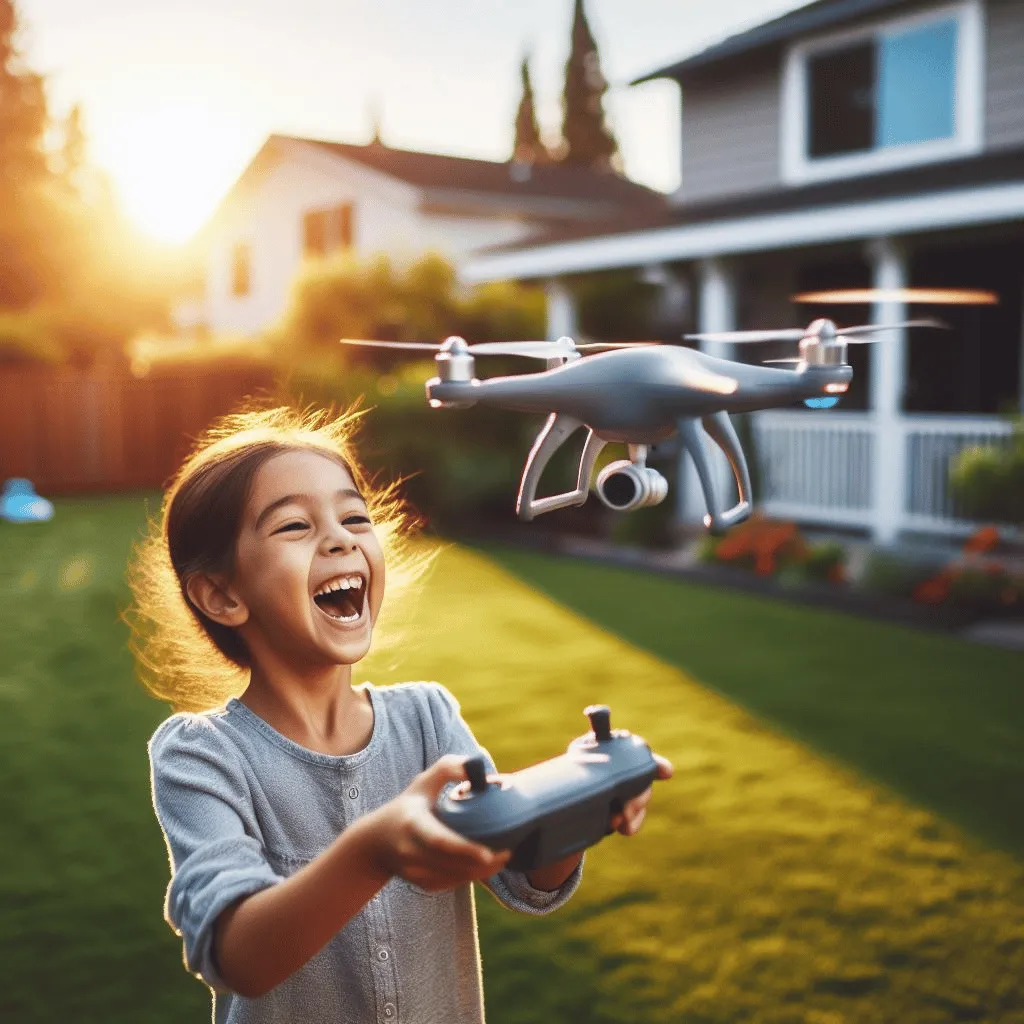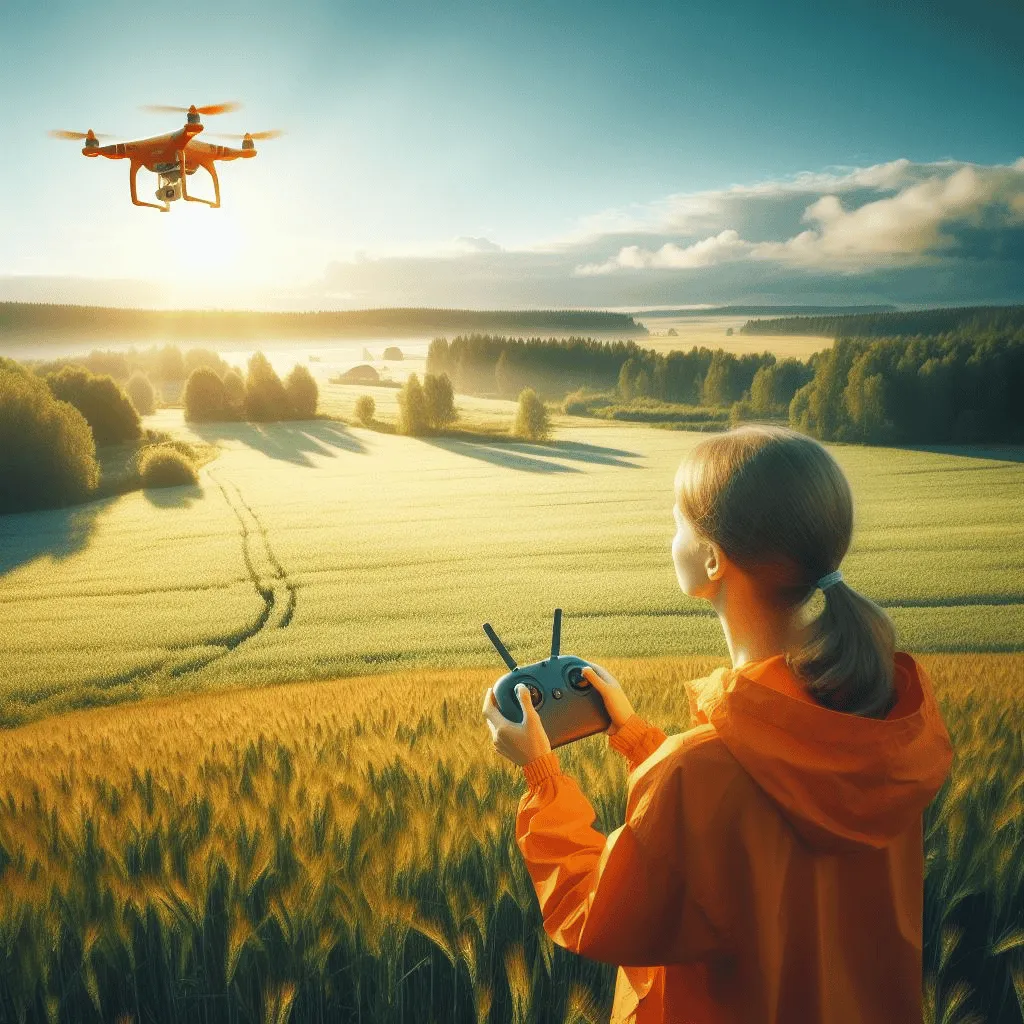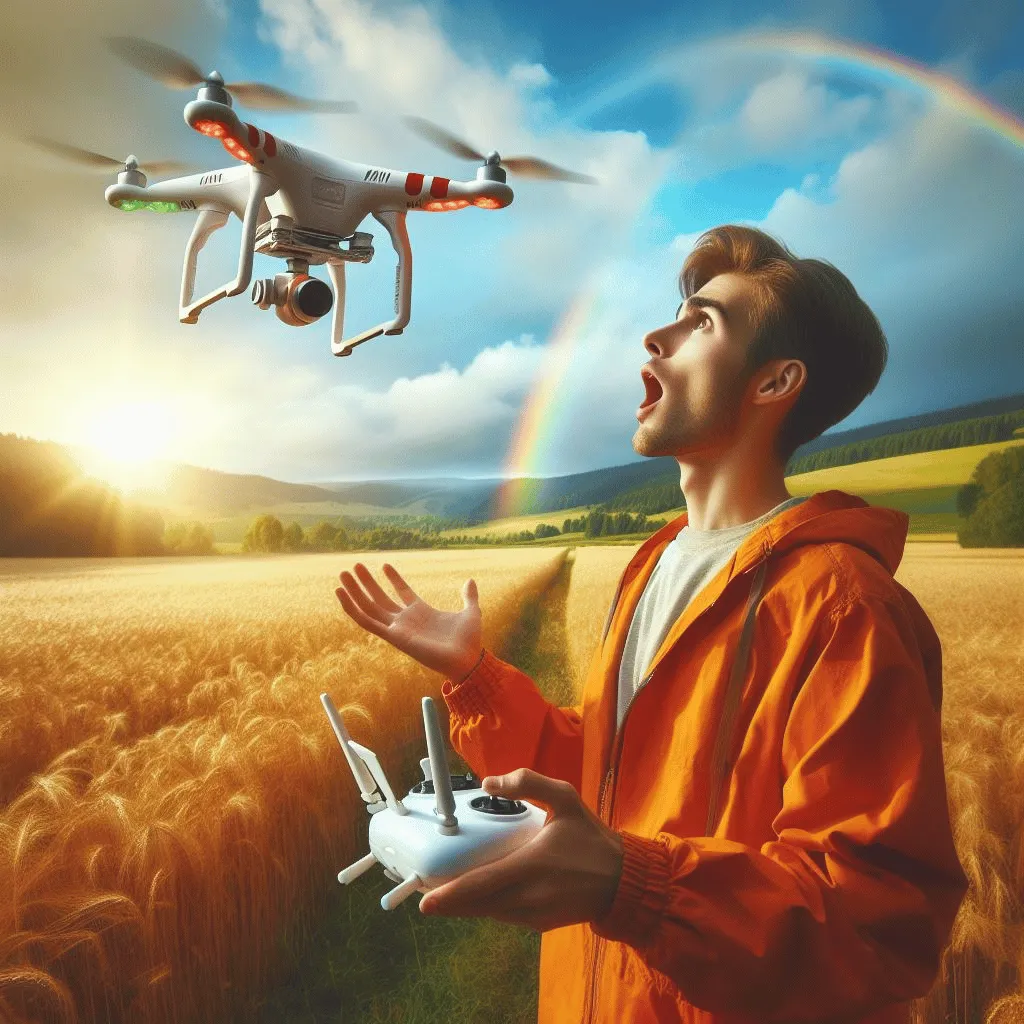Are Drones Hard to Fly? (How You Can Make it Easier in 2024?)

So, you’ve finally decided to take to the skies with a drone. Congratulations! But before you embark on this exciting aerial adventure, you may be wondering: are drones hard to fly? Well, fear not, my fellow aspiring drone pilots, for I am here to shed some light on this buzzing question.
Let’s face it, flying a drone is not exactly rocket science. Sure, it may seem a bit daunting at first, with all those propellers and buttons, but trust me, once you get the hang of it, you’ll be soaring through the air like a pro.
Now, I won’t sugarcoat it – there is a bit of a learning curve involved. But hey, what fun would it be if everything came easy? Learning to fly a drone is like learning to ride a bike – it may take a few wobbly attempts, but once you find your balance, the sky’s the limit!
Is it very hard to fly a drone for beginner?
Flying a drone as a beginner can be either a breeze or a bit challenging, depending on a few key factors. First off, the type of drone matters a lot.
If you’re starting with a toy drone, you’re in for an easier ride. These drones are small, light, and come with simple controls. They are great for beginners and can be flown indoors or outdoors in calm conditions.
On the other hand, camera drones are a bit more complex. They’re larger, heavier, and pack features like stabilization systems and cameras.
This means more practice and skill are needed to handle them smoothly. And then there are FPV racing drones, which are built for speed and agility, making them a tough choice for beginners.
Your prior experience also plays a role. If you’re starting from scratch, be prepared to spend some time on basic maneuvers.
However, if you’ve dabbled with RC helicopters or airplanes before, you might find flying a drone a tad easier due to your existing understanding of controls and maneuvering.
Now, let’s break down the difficulty levels:

Read More: What Does Sport Mode Do on a DJI Drone? A Comprehensive Guide 2023
What are the main things that make a drone hard to fly?
Flying a drone can be a bit tricky, especially if you’re just starting out. There are a few factors that can make it challenging for beginners.
Firstly, there’s the control complexity.
Drones often come with multiple controls, and coordinating these can be a bit like patting your head while rubbing your stomach—it takes practice.
Plus, maintaining awareness of the drone’s orientation in relation to you can be a puzzle, especially when flying far away or using FPV goggles.
Some drones, especially the speedy racing models, are super sensitive to controls, making smooth maneuvers a bit of a challenge.
Then, there are environmental challenges.
Wind can throw a curveball, impacting stability and control.
Flying in different weather conditions like rain or snow can limit visibility and affect performance. Navigating around obstacles requires good judgment and spatial awareness.
Next up, drone features can add another layer of complexity.
Some drones come with fancy features like autonomous flight modes and obstacle avoidance.
Learning to master these can take a bit of time. Toy drones may lack advanced stabilization systems, making them trickier to handle.
And don’t forget the camera controls. If your drone comes with a camera, operating it while flying adds another dimension to the challenge.

There are also some general factors to consider.
Learning to fly any drone takes time and practice, and yes, expect a few crashes along the way.
Some people might find it physically challenging to handle the controller for extended periods. And when you’re flying using FPV, seeing the world from the drone’s perspective can be disorienting and might lead to a crash or two.
But don’t worry! With a bit of patience and practice, you’ll be navigating the skies like a pro in no time.
Read More: How to Fly a Drone? Essential Tips for Safe and Successful Drone Flight
What are the different levels of a drone getting hard to fly and how to overcome them?
Navigating the levels of drone flight can be an exciting journey, but each stage comes with its own set of challenges. Let’s break down the difficulty levels and how to overcome them:
Level 1: Basic Control (Easy)
Getting started with drone flying involves mastering fundamental controls and maneuvers. Begin with a beginner-friendly drone and focus on:
Overcome these challenges by practicing in a calm, open area, mastering basic maneuvers like lift-off and landing, and using a flight simulator before venturing outdoors.
Level 2: Smooth and Precise Flight (Moderate)
As you progress, the goal is to achieve smoother and more controlled flight. Challenges include making precise turns, flying in various conditions, and adjusting for drone tilt. Overcome these hurdles by:
Level 3: Advanced Maneuvers (Difficult)
Now, it’s time for more complex maneuvers, such as flips, rolls, and loops. Additional challenges include flying in strong wind, controlling the drone while operating the camera, and navigating confined spaces. Overcome these difficulties by:
Level 4: FPV Racing (Expert)
For the ultimate challenge, enter the world of FPV racing, where high-speed flight and precision are paramount. Challenges include maintaining visual orientation through FPV goggles, quick decision-making, and obstacle avoidance. To conquer this level:

Read More: What is The Best Drone Buying Guide? A Comprehensive Guide
How can a beginner drone pilot learn to fly a drone and make it easy?
Learning to fly a drone can be an exciting and enjoyable experience. To make it easy and fun, follow these tips:
Before You Take Off:
Choosing the Right Drone: Start with a beginner-friendly drone that has simple controls and stable flight features, such as toy drones or camera drones with beginner modes.
Reading the Manual: Take some time to read and understand the drone’s manual, covering controls, features, and safety instructions.
Downloading the App: If your drone has an app, download it and familiarize yourself with its interface for control, camera settings, and live feed.
Finding a Safe Flying Area: Pick a spacious, obstacle-free zone away from people, buildings, and power lines. Ideal locations include parks, fields, or empty parking lots.
Checking the Weather: Ensure calm weather conditions with minimal wind for your initial flights.
Start Flying:
Practicing Basic Controls: Begin with simple maneuvers like lift-off, landing, hovering, and directional changes. Master these before moving on to more advanced actions.
Focusing on Hand-Eye Coordination: Pay attention to your drone’s movements and adjust your controls accordingly to enhance your hand-eye coordination.
Using a Flight Simulator: Take advantage of apps and software that simulate drone flight, allowing you to practice safely in a controlled environment.
Not Being Afraid to Crash: Crashes are part of the learning process. Stay calm, analyze your mistakes, and try again.
Flying with a Friend: Having a friend to assist with launching, landing, and observing your flight can be helpful.

Gradually Progress:
Exploring Advanced Features: Once comfortable with basic maneuvers, delve into controlling the camera, adjusting flight settings, and performing simple tricks.
Challenging Yourself: Gradually progress to flying in different environments, like slightly windy conditions, around obstacles, or in confined spaces.
Joining a Drone Community: Connect with fellow drone enthusiasts online or in local clubs to share experiences, learn from each other, and find inspiration.
Taking Online Courses or Lessons: Consider enrolling in online courses or attending professional drone flying lessons for a structured learning experience.
You can also watch this video:
You should also visit other platforms like Uavcoach.com and Dronelife.com. I have linked the websites and you can visit them and for more details you can also watch this video.
Read More: How to Make Money With a Drone? (17 Best Ways)
Are there specific drones that are easy to fly?
Yes, there are several drones on the market that are specifically designed to be easy to fly for beginners. These drones typically have the following characteristics:
Simple controls: They feature intuitive controls that are easy to learn and use, often with dedicated buttons for takeoff, landing, and hovering.
Lightweight and stable: They are lightweight and have stable flight characteristics, making them less susceptible to wind and easier to control.
Durable construction: They are made with durable materials that can withstand minor crashes and bumps.
Safety features: They include safety features like automatic return to home and altitude hold to help prevent accidents.
Affordable price: They are priced affordably, making them a good option for budget-conscious beginners.
Some examples of drones that are easy to fly:
In addition to the drones listed above, there are many other great options available. When choosing a drone for beginners, it is important to consider your budget, desired features, and skill level.
Tips for choosing a beginner-friendly drone:
By following these tips, you can choose a drone that is easy to fly and perfect for your needs.

Read More: What are the Best Drone Simulators for Android?
What are the common mistakes that beginners make that make them feel that drones are hard to fly?
Beginners often feel frustrated and discouraged while learning to fly a drone, leading them to believe it’s inherently difficult. However, several common mistakes contribute to this feeling, and understanding them can help overcome them and make the process smoother.
Common mistakes:
1. Not practicing enough: Mastering any skill requires dedicated practice, and drone flying is no exception. Beginners often get discouraged after a few unsuccessful attempts, neglecting to put in the necessary practice hours to develop the required hand-eye coordination and spatial awareness.
2. Trying too much too soon: Eagerness to perform advanced maneuvers before mastering the basics leads to frustration and crashes. It’s crucial to focus on fundamental controls like takeoff, landing, hovering, and basic direction changes before attempting complex maneuvers.
3. Flying in challenging conditions: Choosing windy days or confined spaces for first flights significantly increases the difficulty. Beginner pilots should always start in calm weather conditions and open areas with ample space to practice safely.
4. Overcorrecting controls: When the drone deviates from the desired path, beginners often overcorrect with the controls, causing erratic movements and instability. It’s important to make small, gradual adjustments to maintain smooth and controlled flight.
5. Not reading the manual: Ignoring the manufacturer’s instructions for specific features and safety guidelines can lead to confusion and potential problems. Carefully reading the manual provides valuable information about controls, settings, and limitations of the drone.
6. Neglecting pre-flight checks: Failing to check the battery level, propellers, and surrounding environment before taking off can result in unexpected events and crashes. Consistent pre-flight checks are crucial for safe and enjoyable flying sessions.
7. Losing focus: Distractions like phone notifications or conversations can take attention away from the drone, increasing the risk of accidents. Maintaining focus and awareness of the drone’s location and surroundings is vital during flight.
By avoiding these common mistakes and focusing on deliberate practice, the joy of mastering flight and exploring the world from a unique aerial perspective becomes readily attainable for any beginner.

How hard are cheaper and high-end drones while flying?
Generally, high-end drones are easier to fly than cheaper drones for several reasons:
High-end drones often have:
Cheaper drones, on the other hand, may lack some of these features, making them more challenging to fly:
However, this doesn’t mean that cheaper drones are impossible to fly. With enough practice and patience, anyone can learn to fly a drone, regardless of its price tag.
Additionally, some cheaper drones offer beginner-friendly features like altitude hold and headless mode, which can make them easier to learn on.
Ultimately, the difficulty of flying a drone depends on several factors, including your experience level, the specific drone you are flying, and the environmental conditions.

How long does it take for a beginner to fly a drone and won’t feel difficult?
The time it takes for a beginner to feel comfortable flying a drone and no longer find it difficult can vary based on a few key factors. First off, individual factors play a significant role.
If you’ve had experience with RC vehicles or other flying objects, you might grasp drone flying more swiftly. Learning styles, hand-eye coordination, spatial awareness, motivation, and perseverance also influence the learning curve.
External factors also come into play. The quality of the drone matters; high-end models with advanced features are generally easier to learn on.
The practice environment, such as a safe, open area with good weather conditions, makes a difference.
Additionally, access to resources like online tutorials and guidance from experienced pilots can significantly speed up the learning process.
Considering these factors, here’s a rough estimate of the time it might take:
Basic control: Easy – Mastering lift-off, landing, hovering, and basic direction changes may take a few hours to a few days of practice.
Smooth and precise flight: Moderate – Achieving smooth and precise flight can take a few weeks to a few months, depending on individual factors and the drone’s complexity.
Advanced maneuvers: Difficult – Learning complex maneuvers like flips, rolls, and flying in strong wind conditions can take several months to a year or more, requiring dedicated practice and experience.

FPV racing: Expert – Mastering FPV racing, a highly specialized skill, can take several years, requiring extensive experience with all levels of drone flying and exceptional reflexes.
Remember, these are just estimates. The key is to be patient, consistent, and enjoy the learning process. Don’t get discouraged by setbacks, and focus on improving your skills gradually.
With dedicated practice, you will eventually reach a point where flying a drone feels effortless and enjoyable.
Final Thoughts – Are Drones Hard to Fly?
Learning to fly a drone can be an exciting and rewarding experience. While it may seem challenging at first, with patience, practice, and the right approach, anyone can achieve success.
Remember to start slow, prioritize safety, and enjoy the process. Explore the amazing possibilities of drone technology and capture breathtaking aerial views. With dedication and a positive attitude, the sky’s the limit!
FAQs
Refer to your drone’s manual for specific charging instructions. Typically, a charger comes with your drone and connects to a standard power outlet.
Most drones have a failsafe feature that automatically returns them to home or lands them safely in place if signal is lost.
Local regulations vary, but generally, the maximum altitude for recreational drone flight is 400 feet above ground level. Check your local regulations for specific restrictions.
Avoid flying your drone in rain, snow, or other adverse weather conditions as it can damage the electronics and affect performance.
Additional batteries, propellers, landing pads, carrying cases, and camera filters are common accessories that enhance your drone flying experience.





